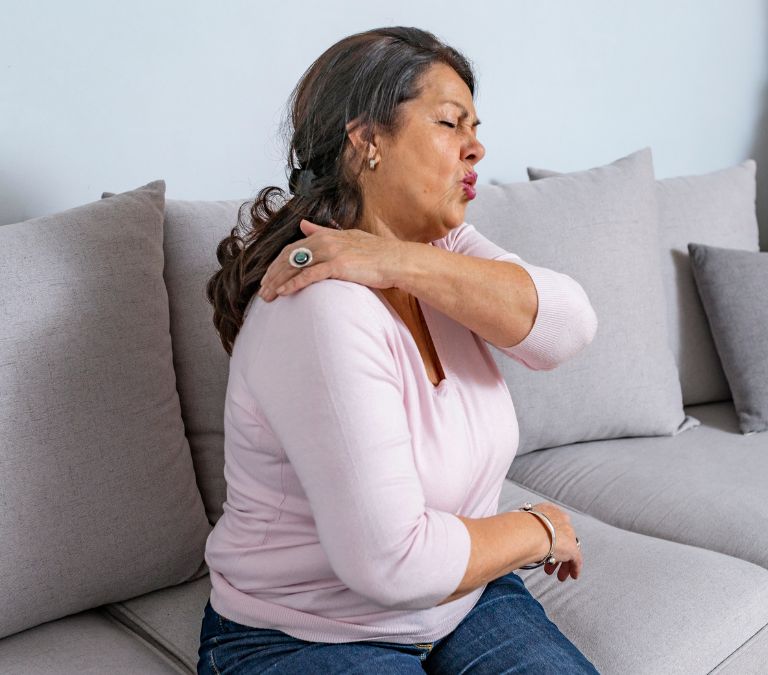Menopause is a natural phase of our life. Once we reach a certain point in our lives, we expect it to come knocking. And when it does, it comes with a load of symptoms. We all know the most common ones, like hot flashes and the cessation of periods. But there are other common but still quite annoying ones. No one told me I would have to deal with symptoms like vaginal dryness and joint and body pains. In this article, we will be discussing menopausal joint pain and body aching during menopause.
The joint and body pain is especially annoying. Menopause is already enough of a reminder that I am aging. Why do I wake up every day feeling like I aged 10 years in one night? Menopausal joint pain might not be as common as hot flashes, but it does pack its punch. I was reading a study recently, and I saw an 85% chance of having body aches and joint pains among menopausal women – you may read all the menopause facts and figures here. That means many menopausal women feel this pain daily for the rest of their lives! Does this not sound like a life you’d want to live?
Hopefully, by the time you are done reading this, you’ll know how to deal with body aches and menopausal joint pains.
What Causes Menopausal Joint Pain And Body Aches?
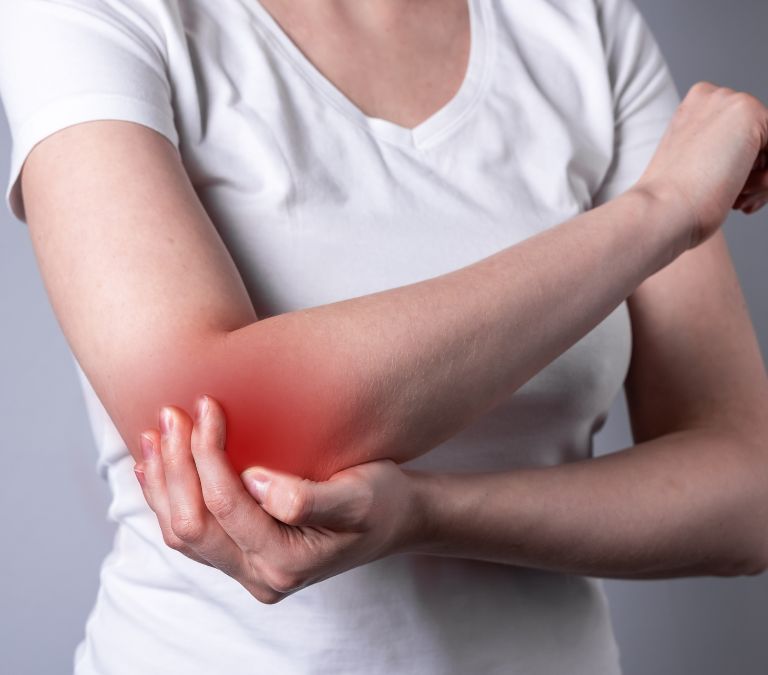
Now, most women would put the aches and pain they feel during menopause on the effects of aging, and this isn’t surprising considering that menopause occurs in our later years.
But much of the evidence points to the fact that menopause plays a certain role in the body pains and joint aches we feel. Let’s take a better look at how it does this.
Menopause Comes With Hormonal Changes
I think we already know this much, but I want to reiterate it. During menopause, your hormones fluctuate, with estrogen seeing a marked decrease. This fall in estrogen level is said to be directly linked to body pains and joint aches. For example, estrogen has the function of maintaining fluid regulation all over the body. When these do not occur, the joint will lose some of its functionality and become painful to move.
Water makes up to 80% of cartilage. It makes it essential for the functionality of this flexible and protecting tissue that works as a shock absorber and friction reducer between the bones. Synovial fluid, a gel-like substance that lubricates the cartilage and allows the joints to move without friction, also contains water.
Water is also required to maintain the ligaments’ and tendons’ flexibility and suppleness. Ligaments are necessary for joint stability, whereas tendons connect muscles to bones. Your range of motion and ease of movement can be limited when your ligaments and tendons lose their suppleness. So you can see that while your joints might seem to be made of strong material, water is invariably important if they work well.
As a result, if there isn’t enough water in the body, the flexibility and lubrication of joint tissues can suffer.
There is also the fact that estrogen is an anti-inflammatory substance, and reducing estrogen means more susceptibility to inflammation.
Dehydration
Dehydration is another reason for the joint pain you feel every morning when you wake up. I know how we scoff at those ‘drink water’ ads. But as we get older, we must start paying attention to these things. Not drinking enough water can lead to dehydration. And for menopausal women, this can be very bad, especially for those with severe hot flashes and night sweats.
It means you are losing lots of water and not replacing them as quickly as you should. If you paid attention to what I said before about estrogen regulating the body’s fluid content, you would know that not getting enough water is not good for your joints. So if you wake up in the morning with stiff joints and body pains, then there is a possibility that you are not getting enough fluid into your system. It’s especially important if you have night sweats.
Now, dehydration also causes another type of condition. When you are not taking enough fluid, your kidneys suffer. They cannot fully perform their function of eliminating urea from the body. It can result in microscopic, sharp crystals in and around joints, causing them to become inflamed and painful.
Stress
Yes, stress can also lead to body and joint pains. It should not surprise us, though. We all know how stiff and achy our bodies are in the morning after a very stressful day. And as we become menopausal, the stress increases. We not only have to struggle with the stress of our everyday lives but also deal with the stress being a menopausal woman brings. Imagine finally crawling into bed after a stressful day, and just when you are about to get the much-needed sleep, you start sweating buckets because of an episode of hot flashes.
How does stress bring about pain? When you’re under a lot of stress, your body produces a lot of cortisol, a stress hormone. Interestingly, cortisol also plays another role. When this hormone is present for a long time, it acts as an inflammatory agent. Therefore excessive amounts of stress during menopause will only make your joint discomfort worse.
Then there is the fact that our muscles stiffen up due to stress. As a result, this tension makes our joints work much harder, which can contribute to more inflammation and discomfort. If you are prone to stress, you must take time to relax every day.
Weight Gain
If you have ever googled the symptoms of menopause, I am certain that weight gain will be among the first symptoms you are likely to find. The hormonal and lifestyle changes that occur during menopause make it a lot easier to add weight, especially around the abdominal region. Weight gain puts extra strain on weight-bearing joints, including the knees and hips. I read that every pound of extra weight on the knees adds around 4 pounds of pressure. Imagine what 10 pounds could do to your joints.
Pain due to menopause can be very frustrating. Unlike other menopausal symptoms, this particular symptom might continue even after your hormones level out during the postmenopausal stage. And they have some very painful effects on the body, creating aches and pains around the body, especially on the joints. These pains will present themselves in different ways, but the most common is
- Cramps And Joint Pains
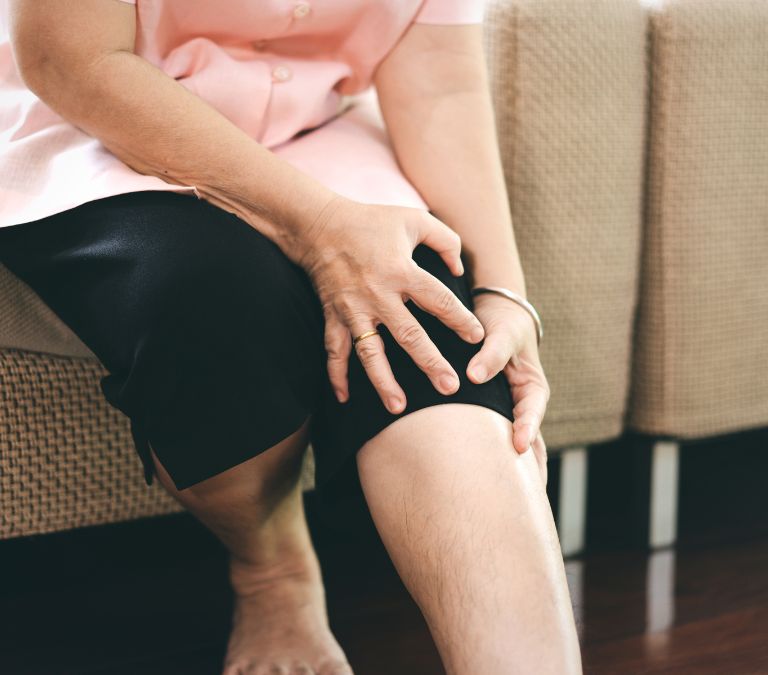
The changes during perimenopause and menopause might leave you with extremely painful cramps. These cramps tend to be intense and crippling. The kind of pain you would not want to become recurring.
There are also joint pains, which become more regular. You will start feeling pains in joints like your neck, knees, shoulders, and hands. Any of your joints, from the smallest ones like your fingers and toes to the largest ones like your hips and knees, might be affected.
What do these pains feel like? Menopausal joint pain is achy, stiff, and creaky feelings and a burning sensation around the joints. These may be severe in the morning and improve over the day. While discomfort can be localized to a single joint or a few joints, many women report a general aching sensation.
The thing about these is that because the anti-inflammatory function of estrogen is missing, there is every chance these pains might develop into Menopausal arthritis.
- Migraines
As if the joint pains weren’t enough, it is sometimes accompanied by migraines. However, there isn’t much detail on how menopause causes this. In fact, in some cases, menopause causes a decrease in migraines.
- Fibromyalgia
Fibromyalgia is a chronic pain condition. It is a condition of heightened pain sensitivity. In essence, if you were to have this condition, you would have widespread pain. It means that you’d feel pain all over your body.
- Easy Bruising
Hormone fluctuations and decline have an impact on the outside of the body as well. Low estrogen levels might lead to a loss of skin suppleness. It also reduces the skin’s ability to retain water, which it utilizes to protect itself from harm. It causes the skin to be thin, resulting in painful bruising. Bruising is most sensitive on the backs of the hands.
- Increased Sensitivity To Body Pains
Sleep deprivation has been shown to increase our pain sensitivity. It is very common among menopausal women. According to research, sleep deprivation can affect the circuitry in the brain in ways that intensify the pain.
Magnesium deficiency might also affect your sensitivity to pain and cause sleeping issues. Stress and digestive weakness are major causes of low levels of this vital mineral during menopause.
Magnesium is also required to keep muscles relaxed. Thus, deficiency can cause them to stiffen up and become tight, affecting the muscles that control joint mobility.
How Do You Handle Menopausal Joint Pain And Aches?
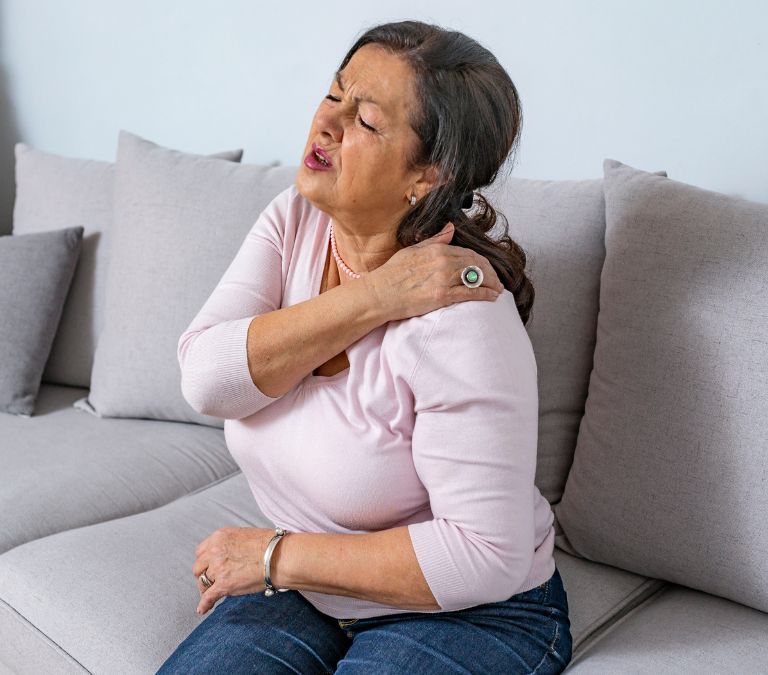
Menopausal joint pain can become very troubling. It can easily affect your everyday life and makes for a grumpy and annoyed woman. And honestly, do we want to spend the rest of our lives smelling like topical pain relievers? I do not. I spent some time looking at how we can manage these particular symptoms.
Natural Remedies
When you start experiencing these pains, especially if they are mild, there are a few things you can do that would probably help reduce or even eliminate them. Let’s start with the basics.
- Monitor Your Diet
The things we eat have a direct effect on how our body feels. Food items will greatly improve your overall health, including the health of your joints. Likewise, food items can leave your body worse off than they found. You must pay attention to what you eat, especially at this stage of your life.
A majority of the pain we feel is due to or is capable of leading to menopause. We need to eat food that will help with the reduction of inflammation. Some food Items with anti-inflammatory properties include:
- Foods rich in antioxidants: Anthocyanins are the most common kind to be seen in foods. Anthocyanins are potent antioxidants that aid in the reduction of inflammation. Cherries, raspberries, blueberries, and broccoli are examples of brilliantly colored fruits and vegetables that contain them.
- Foods rich in omega-3 oil: Oily fish like herring, mackerel, sardines, salmon, and tuna, for example, contain these anti-inflammatory oils. Omega-3 fatty acids can also be found in walnuts, almonds, chia seeds, and soybeans.
- Some fruits and vegetables have anti-inflammatory effects. Therefore, eat a balanced diet rich in fresh fruits and vegetables like pineapple, apples, avocados, and mushrooms.
Also, try and avoid certain foods. Ensure you reduce your intake of refined sugars; I know this can be very hard. When you enter every food enterprise in the nation, you are bombarded with an assortment of foods packed with refined sugars. But these foods are generally not good for our health. They are particularly not good when it comes to reducing body pains too.
We talked about how weight gain can exacerbate joint pains, so why do we eat things that will increase our weight? Also, you should cut out other foods that count as triggers for these menopausal pains. Foods that contain caffeine and fizzy drinks, as well as too much dairy, could all be the reason why you wake up feeling sore. Most times, just reducing or eliminating these foods from your diet will go a long way in helping you get relief from menopausal pains.
- Drink A Lot Of Water
Menopause means your body is also having many issues regulating fluids since one of the major hormones for managing this function has not been produced much. Lack of fluids in the body might lead to dehydration. We have already talked about this. You need to take in as much water as possible to combat this.
Beyond just other liquids like coffee and tea, you should aim to drink 1.5-2 liters of pure water (not artificially flavored or sweetened) every day. If you also have frequent hot flashes or night sweats, you might need to consume even more water as you might have lost more water while sleeping. Something as simple as drinking the right amount of water could reduce pain and give you a better quality of life
- Exercise, Exercise, Exercise
Exercise might sound shocking to you, and I understand why. We sweat buckets when we exercise. Since we already said dehydration is bad for managing body pains, why should we exercise and lose that much fluid? Staying active increases your flexibility and the credibility of your joints. Stay away from high-impact routines as this could have an opposing effect on your joints.
The best options are yoga, pilates, non-weight bearing, and low-impact weight-bearing exercises. The trick is to take it slow and focus on your lower body as they support the other parts of your body. Do not jump into exercising immediately. Do some stretches and warm-ups before starting, so you do not end up spraining a muscle and becoming immobilized. That will have the opposite effect on your body.
Try alternating between hot and cold compresses when you are feeling any form of pain. It has been proven to help reduce pain.
Hormone Replacement Therapy
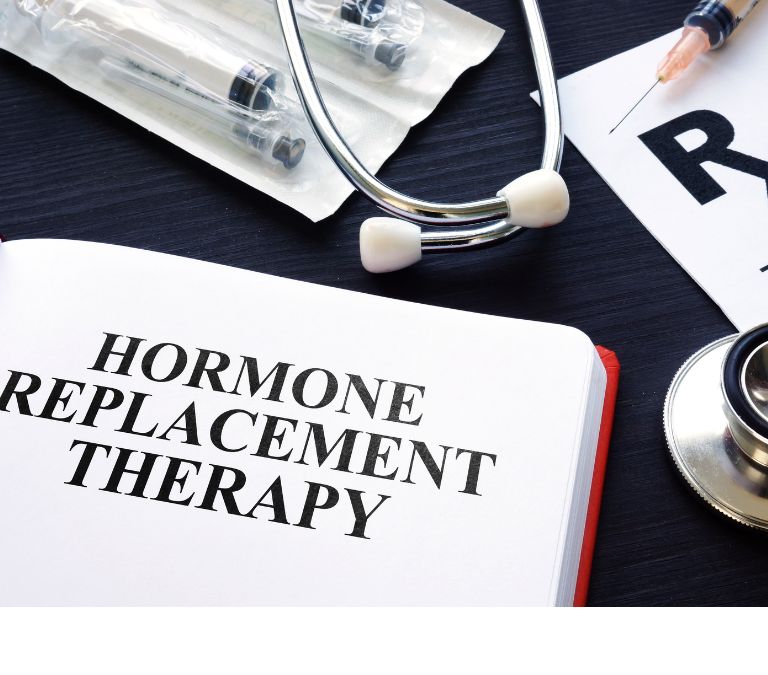
Hormone replacement therapy (HRT), also referred to as hormone therapy (HT) or menopausal hormone therapy (MHT), is a type of drug that replaces the hormones that a woman’s body stops manufacturing after menopause. HRT is a hormone replacement therapy (HRT) that is used to address symptoms of menopause.
Hormone therapy (HT) is a treatment that increases your hormone levels while alleviating some signs of menopause. And one of the symptoms it has been known to address is body aches and joint pains. The estrogen is a part of the therapy you are getting.
It plays a role in the distribution of fluids, thereby reducing dehydration and maintaining the credibility of your body’s joints and musculoskeletal components. Estrogen will also reduce the stressful effects that menopause would usually have on the quality of your life. A less stressful life means a well-rested body and reduced body pains.
Whether or if you should try HT treatment is something you should explore with your doctor. HT comes with a slew of health benefits as well as hazards.
While HRT lowers the risk of severe diseases, including osteoporosis, colon cancer, and heart disease, it also raises the risk of blood clots (when taken as a tablet) and breast cancer.
Cognitive-Behavioural Therapy
Cognitive behavior therapy is a non-medical technique that can help with various health issues such as worry and stress, depression, hot flashes and night sweats, sleep issues, and exhaustion. Now, cognitive behavioral therapy might not be an orthodox method of dealing with menopausal pain, but it has shown a lot of promise in the treatment of menopausal symptoms, especially hot flashes and night sweats.
CBT deals with menopausal pain through indirect mechanisms. Let’s look at some ways it does this. We already mentioned that it helps reduce night sweats. It means that you do not get to sweat so much at night, reducing the level of dehydration that you might wake up with. Also, cognitive behavioral therapy has shown much promise in reducing stress. And from what we have already mentioned, stress is one of the major contributors to menopausal pain. With the help of cognitive-behavioral therapy, you can reduce stress and the negative effects on your body and joints.
Acupuncture
Acupuncture is one of the most popular alternative medicine for treating menopausal symptoms. Acupuncture is the traditional Chinese medicine in which a practitioner stimulates certain places on the body using tiny needles inserted through the skin. Sounds painful, right? Well, not necessarily. If you find someone who knows their job, acupuncture is a relatively painless process, and if that person is good enough, you will have the most enjoyable experience.
Acupuncture can be a feasible choice for those like me who can’t or don’t want to take hormone therapy treatments for menopause symptoms. I mean, not all of us have that luxury.
Acupuncture has been shown in several studies to aid with chronic pain. Acupuncture needles inserted into pressure sites on the body stimulate the central nervous system, prompting it to generate pain-relieving compounds like endorphins. These can assist with the aches and pains that come with menopause.
Find a doctor concerned not only with your physical problems but also with your mental and emotional well-being. It will assist you in developing a treatment plan that is tailored to your specific needs.
Aromatherapy
Aromatherapy is frequently utilized in women’s health as a supplemental therapy. Essential oils from herbs, flowers, and other plants are inhaled, massaged, or bathed to promote your well-being and treat various ailments. If you don’t want to take prescribed medications to control your symptoms, you might want to look into other options. When administered to various body parts, essential oils have now been discovered to bring relief.
These oils are derived from various plant sources and are frequently found in their original state. They’re also available in several forms that can be applied right away, such as oils and creams.
Aromatherapy makes use of essential oils. These oils’ essence is intended to be inhaled (directly or via a diffuser) or diluted and applied directly to the skin. Do not take essential oils orally.
Aromatherapy has been used to treat menopausal pain with many positive results. It was shown to reduce that particular symptom almost twice as much as a placebo does.
Qigong
Qigong is one of the oldest forms of therapy. It is a form of alternative therapy that has been practiced in China for the longest time.
Taoist masters devised qigong to enhance health through methodical abdominal breathing, resulting in better total body regulation. Qigong is divided into two categories: hard forms or active forms, which include martial arts, physical exercises, and walking, and soft forms or still forms which include meditation, concentration, sitting, standing, and reclining.
Women can benefit from the ancient wisdom of qigong, according to studies. Qigong has shown a lot of promise in managing menopausal pain. According to most practitioners, your body knows what to heal, and qigong helps it do just that. Including qigong in your self-care practice is a great way to combine old knowledge with modern science. It can also assist you in learning to be present in your body when a lot is happening.

